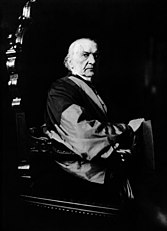
Back Representation of the People Act 1884 German Reform Act (1884) Finnish 1884년 선거법 개정 Korean 1884年人民代表法令 Chinese
| Act of Parliament | |
 | |
| Long title | An Act to amend the Law relating to the Representation of the People of the United Kingdom. |
|---|---|
| Citation | 48 & 49 Vict. c. 3 |
| Introduced by | William Gladstone |
| Territorial extent | United Kingdom |
| Dates | |
| Royal assent | 6 December 1884 |
| Other legislation | |
| Repealed by | Representation of the People Act 1918 |
| Relates to | Redistribution of Seats Act 1885 |
Status: Repealed | |

In the United Kingdom under the premiership of William Gladstone, the Representation of the People Act 1884 (48 & 49 Vict. c. 3), also known informally as the Third Reform Act,[1] and the Redistribution Act of the following year were laws which further extended the suffrage in the UK after the Derby government's Reform Act 1867.[2] Taken together, these measures extended the same voting qualifications as existed in the towns to the countryside, more than doubling the electorate in the counties, and essentially established the modern one member constituency as the normal pattern for parliamentary representation.[3]
The bill was introduced by Gladstone on 28 February 1884. The Conservative-dominated House of Lords rejected the bill on 17 July but then passed it. It gained royal assent on 6 December of that year.[4]
The Act extended the 1867 concessions from the boroughs to the countryside. All men paying an annual rental of £10 and all those holding land valued at £10 now had the vote.[2] This significantly increased the electorate; in the 1880 general election, before the passing of the Act, 3,040,050 voters were registered, while in the 1885 general election, after the passing of the Act, there were 5,708,030 registered voters.[5] The bill was so objectionable to the House of Lords that Gladstone was forced to separate the legislation into two bills,[2] the second being the Redistribution of Seats Act 1885, which redistributed constituencies in order to equalise representation within constituencies across the UK.[6]
The 1884 Reform Act did not establish universal suffrage: although the size of the electorate was increased considerably, all women and 40% of men were still without the vote.[7][8] Male suffrage varied throughout the kingdom, too: in England and Wales, two in three adult males had the vote; in Scotland, three in five did; but in Ireland, the figure was only one in two.[8]
- ^ Hayes, William A. (1982). The Background and Passage of the Third Reform Act. Garland Pub. ISBN 978-0-8240-5156-3.
- ^ a b c McKechnie, The reform of the House of Lords p.49
- ^ Blackburn, Robert (February 2011). "Laying the Foundations of the Modern Voting System: The Representation of the People Act 1918: Laying the Foundations of the Modern Voting System". Parliamentary History. 30 (1): 33–52. doi:10.1111/j.1750-0206.2010.00237.x.
- ^ Jones, Andrew (2008). The politics of reform 1884. Cambridge: Cambridge University Press. ISBN 978-0-521-08281-5. OCLC 233543817.
- ^ Craig, Fred W. S. (1989). British electoral facts, 1832–1987 (5th ed.). Aldershot, Hants., England: Parliamentary Research Services, Dartmouth. ISBN 0-900178-30-2. OCLC 20057069.
- ^ Lowell, A. Lawrence (1912). The Government of England. Vol. 1. London: Macmillan. p. 199.
- ^ Pilkington, Colin (1999). The Politics today companion to the British Constitution. Manchester University Press. p. 134. ISBN 978-0-7190-5303-0.
- ^ a b Cook, Chris (2005). The Routledge Companion to Britain in the Nineteenth Century, 1815-1914. Routledge. p. 68. ISBN 978-0-415-35970-2.